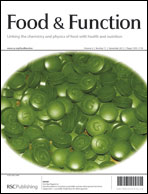Molecular disassembly of starch granules during gelatinization and its effect on starch digestibility: a review
Abstract
Starch is the most important glycemic carbohydrate in foods. The relationship between the rate and extent of starch digestion to produce glucose for absorption into the bloodstream and risk factors for diet-related diseases is of considerable nutritional interest. Native starch is attacked slowly by enzymes, but after hydrothermal processing its susceptibility to enzymatic breakdown is greatly increased. Most starch consumed by humans has undergone some form of processing or cooking, which causes native starch granules to gelatinize, followed by retrogradation on cooling. The extent of gelatinization and retrogradation are major determinants of the susceptibility of starch to enzymatic digestion and its functional properties for food processing. The type and extent of changes that occur in starch as a result of gelatinization, pasting and retrogradation are determined by the type of the starch, processing and storage conditions. A mechanistic understanding of the molecular disassembly of starch granules during gelatinization is critical to explaining the effects of processing or cooking on starch digestibility. This review focuses on the molecular disassembly of starch granules during starch gelatinization over a wide range of water levels, and its consequential effect on in vitro starch digestibility and in vivo glycemic index.


 Please wait while we load your content...
Please wait while we load your content...